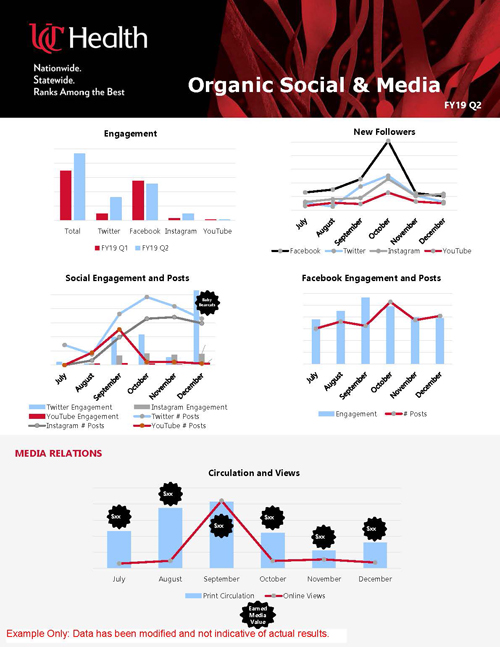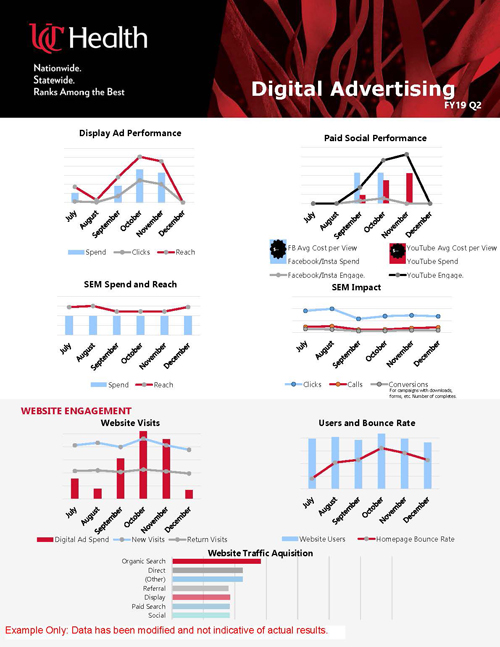MARKETING
UC Health Is Operationalizing Measurement of Its Marketing Efforts
In health care marketing obtaining the data you need is no longer the problem, with reams of information at your fingertips. Rather, the challenge is in pinpointing the right data to effectively guide decision making and influence key stakeholders in the organization to approve promotional initiatives.
The marketing department at UC Health has been on this journey for the better part of a year as it has worked to operationalize its marketing measurement process. Fast forward to today and the Cincinnati-based health system has created a dashboard that houses all of its meaningful metrics and is becoming the go-to source of information for the department and senior management.
 “This has drastically changed the conversation for us,” said Allison Neikirk, consumer insights and marketing manager for UC Health. “Leaders are realizing that marketing does not just ‘do billboards’ or make things ‘look pretty’. We know what we’re doing. And as we continue to integrate this dashboard into our everyday work, I’m hoping we continue to be seen as a department that’s measuring the right things, moving the needle and leading the way,” she said.
“This has drastically changed the conversation for us,” said Allison Neikirk, consumer insights and marketing manager for UC Health. “Leaders are realizing that marketing does not just ‘do billboards’ or make things ‘look pretty’. We know what we’re doing. And as we continue to integrate this dashboard into our everyday work, I’m hoping we continue to be seen as a department that’s measuring the right things, moving the needle and leading the way,” she said.
Step by Step
Although UC Health is only months into utilizing the dashboard, Neikirk emphasized how crucial the tool is for any health care organization, as it helps with everything from budgeting to determining spending.
UC Health collaborated with Cincinnati-based health care marketing expert Mimi Rasor to implement a seven-step process for developing a dashboard:
- Take an inventory of your metrics. This includes measuring response to advertising, direct mail and e-mail campaigns; tracking call center volume and website and social media statistics; and more. It also includes monitoring metrics that gauge a health system’s overall success, such as key performance indicators, market share and patient experience.
- Identify and connect with subject matter experts. Find those who own and oversee these key sources of data across the enterprise, and share with them the purpose and need for a marketing dashboard. At UC Health, this included hosting a workshop for such experts to kick off the reporting of the data, establishing roles and expectations and updating important stakeholders on the progress.
- Develop a data collection process. Neikirk said this step included assigning responsibilities, with many pieces of data coming from already existing sources. Those involved determined how information would be shared internally and by whom.
- Start the data collection process. Allow team members ample time to gather the first wave of information, going back at least two quarters if not one year. Neikirk suggested holding check-in calls at least every other week for 15 to 30 minutes, and settling on a standardized reporting format.
- Analyze the data and add context. Now begins the harder work of understanding what all of this information means. For UC Health, Rasor said the team dug into the data by calculating cost per impression for campaigns, evaluating and interpreting trends and forming hypotheses about why certain tactics were failing to produce desired results.
- Report and optimize the strategy. Determine whether marketing efforts are matching the key performance indicators you’ve established. Is a shift in strategy required? If so, Rasor and Neikirk advised testing another approach while being careful not to pull too many levers at once because it can be difficult to tell what’s working.
- Integrate throughout the organization. Now that the heavy lifting is done, you need to confirm that executives and staff are actually using the dashboard, ensure that marketing measurement is becoming engrained in the organizational culture and look for further opportunities to integrate it into routine processes and meetings.


Images do not reflect actual data.
Lessons Learned
In creating marketing dashboards, Neikirk cautions that it’s a project that takes time and resources, and may get a “little bumpy” along the way.
Rasor said that holding an initial kickoff meeting with subject matter experts was “essential.” “It ensured that team members were on the same page and that the key players involved understood the dashboard.” She and Neikirk urged other leaders to simplify how they think about marketing measurement and test and learn along the way. They also stressed the importance of integration on the back end.
Gaining buy-in from the C-suite also proved pivotal in the early stages, Rasor added. “You need to have backing from senior management in order to get an initiative like this off the ground.”
Less than a year after launching UC Health’s marketing dashboard, Neikirk noted the marketing department is already reaping benefits, in terms of an improved ability to gauge the success of promotional efforts and monitor progress toward achieving overall organizational objectives. She also said it has helped to elevate the department’s perception within the organization.
This article features interviews with:
Allison Neikirk
Consumer Insights and Marketing Manager
UC Health
Cincinnati, Ohio
Mimi Rasor
President
Rasor Marketing Communications
Cincinnati, Ohio


